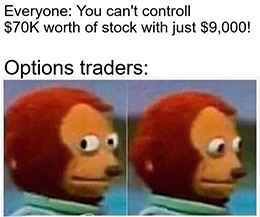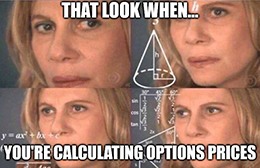
Stocks on Sale: Time for Option Shoppin’
Wow, I’m Great Stuff-ed after that Thanksgiving! How are you feeling, Great Ones?
I hope you’re not too sluggish, because today we’re breaking through that day-after food coma to serve you a healthy heaping of options.
Options? I’m seriously food-hung-over. Why now?
Well, look at it this way: Everyone’s traded the pandemic different, and judging by the emails your fellow readers have written in, the Great Ones out there are no one-stock ponies. No siree!
Some of you grabbed the bull by the horns, took a few Great Stuff Picks and traded options on them to make bank. Congrats!
Others have used options to minimize downside losses, like a Swiss Army knife cutting through the volatility. And that’s the thing: We truly don’t know when uncertainty shall rear its ugly head again, when volatility and panic may grip the market at a moment’s notice.
And by then, it’s too late to know how to react. That’s where today’s dose of Greatness comes into play.
You thought Best Buy had the best Black Friday deals going on? Nope, forget that.
Today, we’re teaching you everything you need to know to make bank with options … 100% free. How’s that for a Black Friday deal? And you didn’t even have to wait in a line or battle online shopping bots! (Stupid PlayStation 5…)
Don’t worry, we’ll take it slow — just the basics today. And if you have any questions, just reach out to GreatStuffToday@BanyanHill.com. Trust me, it doesn’t take me much to start ranting and raving about options, so drop us a line anytime.
Square 1: Contracts to Care About
Trading ain’t all about holding stocks and hoping for the best, you know. Sometimes you want to feel that quick, fast and loose trading frenzy take hold of you … or maybe you have a more balanced approach in mind.
Either way, an option is a contract that gives you the right (but not the obligation) to buy or sell a stock at a certain price. Like every contract, an option contract has two sides: the side that sells the contract and the side that buys the contract.
Essentially, the contract you buy determines the price you think a stock will reach (or fall to).
But these contracts don’t last forever. They expire after a certain time, typically on monthly, weekly or yearly intervals. After all, who wants contracts sitting out there in the market void until the end of time? You have a schedule to keep.
You still with me? Quick recap: Options contracts let you buy or sell stocks at a set price by a set day.
Now, this is where it gets a bit complicated … but only a bit. Each option contract typically represents 100 shares of a stock. When you see an option for Tesla Inc. (Nasdaq: TSLA), that one contract controls 100 shares of TSLA.
When you see option prices, the price you’ll see is for each individual share in a contract. Yet, your option contract lets you control a whopping 100 shares! (Take that, stock investors.)
So when you see the price of an option on Robinhood, Schwab or what have you, multiply the price by 100 to arrive at the total cost of your contract.
For instance, let’s say you want TSLA options that expire in May. You see that a particular TSLA May option is priced at $90. (This is just an example price … your results will vary.)
Now, you might think that you can buy that option contract for just $90 … nope. Remember to multiply that $90 by all 100 shares of TSLA that the contract represents.
As such, your TSLA May option would actually cost you $9,000. That may seem steep, but it’s a lot cheaper than actually buying 100 shares of Tesla. (Don’t worry, not all options are this expensive.)

Now, the price you pay for one options contract will depend on the strike price you select for the underlying stock.
Hold up … strike? Who’s getting hit?
“Strike” is fancy options trading lingo for the price at which you want to buy or sell a stock. So, a TSLA $700 strike call option means you want to pay $700 for TSLA shares. In our example here, buying one contract of this option would cost $9,000, and you’d have control over 100 TSLA shares at the price.
When you consider buying 100 shares of Tesla at $700 would set you back $70,000 … that almost seems like a bargain by comparison. But remember, not all the trade setups you’ll find will be that expensive.
Nevertheless, this is called leverage, class! Options let you take an interest in a stock with much less money than you would otherwise need to buy the shares outright. It’s the entire reason that people trade options to begin with.
I know that’s a lot to take in. But, if you’re still following along, you’re doing fine! Leverage is your friend (most of the time, don’t @ me). So let’s see what a lil’ bit of leverage can do for you.
Calls and Puts: The Nuts and Bolts of Options
I love getting more leverage in my trades … but what’s a “call?”
OK, so there are two basic types of options: calls and puts.
A call option gives you the right (but not the obligation) to buy a stock at a certain price (or strike) in a certain time frame. That TSLA May $700 strike call I mentioned above? It lets you buy 100 shares of TSLA for $700 each before the contract expires in May.
Similarly, a put option is a contract that gives you the right (but not the obligation) to sell a stock at a certain strike price in a certain time frame. Keeping with the Tesla example, a TSLA May $700 put option would allow you to sell 100 shares of TSLA for $700 before the contract expires in May.
Why would you ever want a put?
Well, with any stock you hold shares in right now, you can only make money if the stock goes up. Why not make money when it inevitably goes down? Even the strongest, most bullish stocks in the world pull back eventually … and you may as well make money on it in the meantime.
But Mr. Great Stuff, what if I don’t want to buy 100 shares of Tesla? I can’t afford that!
What, you don’t have $70,000 just lying around to buy TSLA stock? Amateurs…
Don’t worry. Don’t worry…
Expiration Dates and Celebration Days
While some people do use options to actually buy and sell shares, most traders cash in their options before they expire! That’s right: You can use options to make money off the contracts themselves — without ever touching a share of the stock.

Remember, an option gives you the right — but not the obligation — to buy or sell the stock.
As a stock goes up and down in value, so does the value of options on that stock. Specifically, a call option climbs in value when the stock goes up, and it falls in value when the stock goes down. (Vice versa with put options.)
To keep this simple, we won’t go into the complicated way that options are priced. Just know that there are three factors that determine an option’s price:
Intrinsic value: The actual price of the option contract minus all other outside influences.
Time value: The portion of an option’s price assigned to the amount of time left on the contract. Typically, the longer you have for a stock to make the move you want, the more you’ll pay for that window of safety.
Implied volatility: This one gets weird. It’s essentially the market’s estimate of how much a stock will move in a given amount of time. Basically, the price is higher for stocks that move a lot and lower for stocks that don’t move much at all.
That might seem like a lot of scary stuff right there … and I even kept the descriptions as simple as possible. And when you have a dedicated research service leading you into the options market … you hardly have to worry about figuring out the number mumbo jumbo anyway! Click here to learn more.
When you buy an option, you pay for three things: the option (intrinsic value), the time that option is open (time value) and how much the market thinks that stock will move (implied volatility). When your contract expires, its time value and implied volatility fall to zero — there’s no time left on the contract for the stock to keep moving.
Intrinsically Speaking…
We’re going to make this even simpler. For now, let’s only look at intrinsic value in our Tesla example.
As it turned out, TSLA shares soared from $700 to $800 while you held your contract. Congrats! Elon must’ve done something stupid on Twitter if I had to guess.
When our TSLA May $700 call option expires, the intrinsic value of that option would be $100, or a full $10,000 for the entire contract. Remember, you multiply the price of the option by 100 to get the full value of the contract.
Since we paid a total of $9,000 for the contract, our profit would be $1,000. Easy peasy — you made a nice gain on the call contract.

But what if you originally thought TSLA stock would plummet? Let’s run through an example where you bought a put option instead of a call. Remember, puts gain value when a stock goes down.
Say we bought a TSLA May $700 put option for $90. Again, that tallies up to $9,000 per contract.
Turns out that you made the right decision once again, and TSLA stock crashed while you held your put option. Elon must’ve done something stupid on Twitter if I had to guess.
Tesla stock ends up trading at $600 when your put option expires. That option’s intrinsic value would be $100, or $10,000 for the full contract. Our profit again would be $10, or a grand total of $1,000 for the contract.
Clear as mud, right?
What happens if TSLA is below $700 when the call option, what did you call it … expires?
Good question. Even with all the expertise and foresight in the world, not every trade goes our way. But oftentimes, taking a loss in an option trade won’t sting as much as if you held the stock.
That said, remember our golden rule with options! Like all investing, never invest more than you’re OK with losing.
In our TSLA May $700 call example, if Tesla shares are below $700 when our contract expires in May … we get nothing. Nada. Zip. It’s a 100% loss. The same is true for the TSLA May $700 put option. If Tesla is above $700 when this May put contract expires, we get a big ol’ zero.
The great thing is that your initial investment is all you can lose when buying an option. (That’s a great thing?!) Remember that options are a leverage game, letting you control more shares for a fraction of the cost.
Leverage: When Less Is More
Let’s put that 100% loss in perspective.
You paid $9,000 for your TSLA call option, right? That let you control 100 shares. To buy those same 100 shares, it would’ve cost you $70,000. With $9,000, you can only afford 12 shares at $700 each.
If TSLA falls to $600, your option is a complete loss. $9,000 down the drain. If you owned 12 shares, you’re out only $1,200 … if you manage to sell at $600. But that’s with only 12 shares. If you owned all 100, your loss is $10,000. That’s more than what you paid for the option.
Meanwhile, if TSLA rallies to $800, you only made $1,200 on those 12 shares.
But that TSLA $700 call option? It’s worth $10,000 — the same as if you’d owned all 100 shares — and yet, you only paid $9,000 and not $70,000 to get the same return.
That’s what leverage really means: You keep a smaller chunk of your portfolio invested in any one trade … for even more profit potential!
Great Stuff: Data Dump Distilled
Before you get your orders lined up for Tesla calls on Monday … let’s recap today’s options investigation:
- Options are contracts to buy or sell a stock at a certain price in a certain time frame.
- A contract’s “strike price” is the price at which you want to buy or sell the stock.
- Options contracts represent 100 shares of a stock.
- To get an option’s actual price, you multiply the price by 100.
- Buying a call option is a bet that a stock will rise.
- Buying a put option is a bet that a stock will fall.
Now, I bet you’re just itching to get into the options market! That’s where I have to tap in my colleagues, who spend their days knee-deep in the options market. And with how quick their trade setups move, you’ll want to have a guiding hand pronto, honcho!
You have two options here … besides the calls and puts.
First, many of you already love and fan boy over Ian Dyer and Paul , whose Rebound Profit Trader research service uses calls (and sometimes puts!) to great effect. With this dynamic duo, you’ll have two standout guides to the options market — your leg up on this lovely land of leverage.
Click here to learn more about trading options in Rebound Profit Trader.
But I hear you … what about true, OG options simplicity?
Picture this: one trade. One ticker symbol. Once a week. Turns out, that’s all you need to target 100% gains or more — in just two days, on average — with each and every trade, letting you adjust your bullishness or bearishness on a dime.
Volatility fears? Never again! Click here to learn more.
If you have any questions, feel free to send them to us at GreatStuffToday@BanyanHill.com, and we’ll see what we can do!
We’ll catch you on Monday, but don’t forget to follow us on social media too: Facebook, Instagram and Twitter.
Until next time, stay Great!

Joseph Hargett
Editor, Great Stuff









